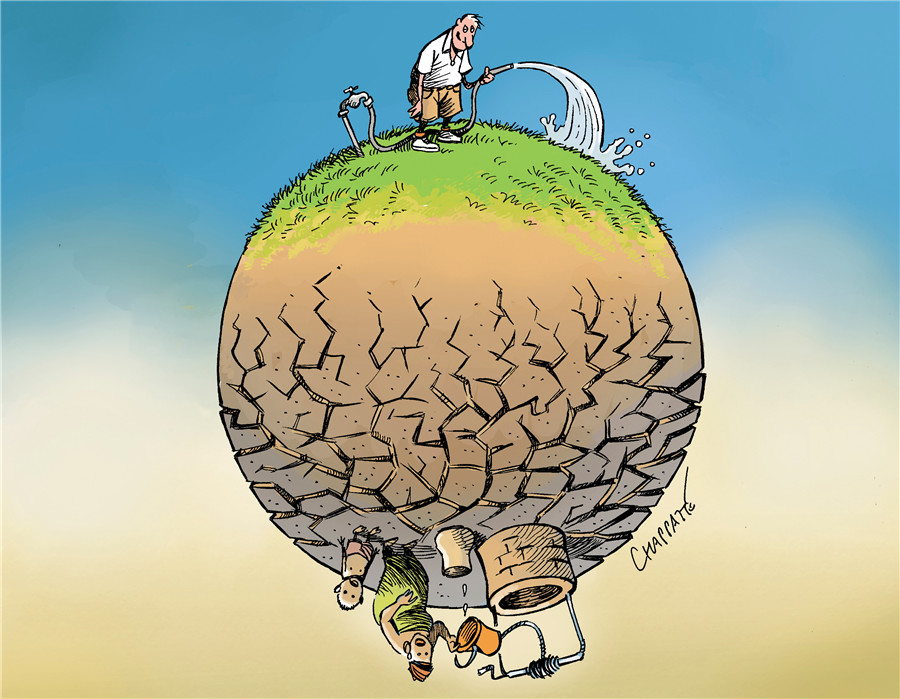“十四五”规划和2035年远景目标重要概念汉英对照(八)
中国外文局 2021-09-27 11:00

2021年初,第十三届全国人大四次会议审议通过了《中华人民共和国国民经济和社会发展第十四个五年规划和2035年远景目标纲要》(以下简称《纲要》)。
中国外文局、当代中国与世界研究院组织各语种中外专家进行全文翻译,经研商审定,形成汉英、汉法、汉俄、汉日、汉西、汉德、汉阿、汉葡、汉韩等9个汉外对照文版。目前汉英、汉日对照版已发布,其他语种将陆续推出。现将《纲要》专栏内容形成汉英对照,供业界及相关人员参考使用。

(十五)环境保护和资源节约工程
Environmental protection and resource conservation projects
1. 大气污染物减排
Air pollutant emission reduction
实施8.5亿吨水泥熟料、4.6亿吨焦化产能和4000台左右有色行业炉窑清洁生产改造,完成5.3亿吨钢铁产能超低排放改造,开展石化、化工、涂装、医药、包装印刷等重点行业挥发性有机物治理改造,推进大气污染防治重点区域散煤清零。
Transform the production capacity of 850 million tons of cement clinkers and 460 million tons of coking capacity and about 4,000 non-ferrous industry furnaces towards clean production, and complete the transformation of 530 million tons of steel production capacity towards ultra-low emissions. Carry out the transformation for treatment of volatile organic compounds in petrochemical, chemical, coating, medicine, packaging, printing, and other key industries, and promote the clearance of bulk coal in key areas of air pollution prevention and control.
2. 水污染防治和水生态修复
Water pollution control and water ecological restoration
巩固地级及以上城市黑臭水体治理成效,推进363个县级城市建成区1500段黑臭水体综合治理。加强太湖、巢湖、滇池、丹江口水库、洱海、白洋淀、鄱阳湖、洞庭湖、查干湖、乌梁素海等重点湖库污染防治和生态修复,实施永定河、木兰溪等综合治理,加快华北地区及其他重点区域地下水超采综合治理和黄河河口综合治理。
Consolidate the achievements in the treatment of black and malodorous water bodies in cities that are at and above prefecture level, and promote the comprehensive treatment of 1,500 sections of black and malodorous water bodies in the built-up areas of 363 county-level cities. Strengthen the pollution control and ecological restoration of key lakes and reservoirs such as Taihu Lake, Chaohu Lake, Dianchi Lake, Danjiangkou Reservoir, Erhai Lake, Baiyangdian Lake, Poyang Lake, Dongting Lake, Chagan Lake, and Wuliangsuhai Lake (Ulansuhai Nur), implement comprehensive treatment of Yongding River and Mulan Creek, and accelerate the comprehensive treatment of groundwater overexploitation in North China and other key areas as well as the Yellow River Estuary.
3. 土壤污染防治与安全利用
Soil pollution control and safe utilization
在土壤污染面积较大的100个县推进农用地安全利用示范。以化工、有色金属行业为重点,实施100个土壤污染源头管控项目。
Promote the demonstration of safe use of agricultural land in 100 counties with large areas of contaminated soil. Focus on chemical industry and nonferrous metal industry and implement 100 soil pollution source control projects.
4. 城镇污水垃圾处理设施
Urban sewage and garbage treatment facilities
新增和改造污水收集管网8万公里,新增污水处理能力2000万立方米/日。加快垃圾焚烧设施建设,城市生活垃圾日清运量超过300吨地区实现原生垃圾零填埋,开展小型生活垃圾焚烧设施建设试点。
Build and renovate 80,000 km of sewage collection pipe network and increase sewage treatment capacity by 20 million m3/day. Accelerate the construction of waste incineration facilities and realize zero landfill of original waste in areas with daily clearing and transportation of urban household waste exceeding 300 tons. Carry out pilot projects for construction of small household waste incineration facilities.
5. 医废危废处置和固废综合利用
Disposal of medical and hazardous waste and comprehensive utilization of solid waste
补齐医疗废弃物处置设施短板,建设国家和6个区域性危废风险防控技术中心、20个区域性特殊危废集中处置中心。以尾矿和共伴生矿、煤矸石、粉煤灰、建筑垃圾等为重点,开展100个大宗固体废弃物综合利用示范。
Shore up weaknesses in medical waste disposal facilities. Build 1 national and 6 regional centers for hazardous waste risk prevention and control technologies, and 20 regional centers for concentrated disposal of special hazardous waste. Focus on tailings and associated minerals, coal gangue, fly ash, and construction waste, and carry out 100 demonstration projects of comprehensive large-scale solid waste utilization.
6. 资源节约利用
Resource conservation and utilization
实施重大节能低碳技术产业化示范工程,开展近零能耗建筑、近零碳排放、碳捕集利用与封存(CCUS)等重大项目示范。开展60个大中城市废旧物资循环利用体系建设。
Implement major demonstration projects for industrial application of energy-saving and low-carbon technology, and carry out major projects such as near zero energy-consumption buildings, near zero carbon emission, and carbon capture, utilization and storage (CCUS). Carry out the construction of waste material recycling system in 60 large and medium-sized cities.
(十六)教育提质扩容工程
Education quality improvement and capacity expansion projects
1. 普惠性幼儿园
Public accessible kindergarten
以人口集中流入地、农村地区和“三区三州”为重点,新建、改扩建2万所幼儿园,增加普惠学位400万个以上。
Build or rebuild 20,000 kindergartens and increase the capacity of public accessible kindergartens to enroll additional over 4 million students, particularly in areas with large population inflows, rural areas, and the “three regions and three prefectures” in extreme poverty.
2. 基础教育
Elementary education
以教育基础薄弱县和人口流入地为重点,新建、改扩建中小学校4000所以上。在边境县(团场)建设100所“国门学校”。
Build or rebuild more than 4,000 primary and secondary schools, particularly in counties weak in education and areas with population inflows. Build 100 “national gateway schools” in border counties (regimental farms).
3. 职业技术教育
Vocational and technical education
支持建设200所以上高水平高职学校和600个以上高水平专业,支持建设一批优秀中职学校和优质专业。
Support the development of more than 200 high-standard vocational schools and more than 600 high-standard programs and support the building of a number of excellent secondary vocational schools and high-quality programs.
4. 高等教育
Higher education
加强“双一流”建设高校基础研究和协同创新能力建设,提升100所中西部本科高校办学条件,布局建设一批高水平公共卫生学院和高水平师范院校。
Strengthen the capabilities of basic research and collaborative innovation in higher education institutions under the initiative of developing top-class universities and academic disciplines, improve the conditions of 100 universities in central and western regions, and build a number of high-standard public health colleges and high-level normal schools.
5. 产教融合平台
Platforms aligning classroom education with real world needs
围绕集成电路、人工智能、工业互联网、储能等重点领域,布局建设一批国家产教融合创新平台和研究生联合培养基地。建设100个高水平、专业化、开放型产教融合实训基地。
Focusing on integrated circuits, artificial intelligence, industrial internet, energy storage, and other key areas, build a number of joint training bases for graduate students, a batch of national innovation platforms and 100 high-standard, professional and open training bases that align classroom education with real world needs.

















 英语点津微信
英语点津微信 双语小程序
双语小程序